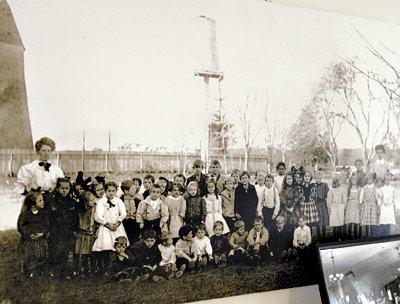Race and Ethnicity on Shelter Island

While the founding families of Shelter Island — the Sylvesters, the Havenses, the Nicolls — are well-known cornerstones of the island’s history, the slaves and Native Americans who built and inhabited the island are not as widely recognized. “Race and Ethnicity on Shelter Island: 1652-2000,” a new exhibition at the Shelter Island Historical Society, celebrates their role in the island’s history.
Nancy Jaicks, a retired professor of history at New York University and part-time island resident, will discuss this aspect of the island’s past Saturday at 1 p.m. at the Havens House Museum. The reception will include light refreshments.
“The minorities on the island have always been here but have never been acknowledged in an exhibition,” said Nanette Lawrenson, executive director of the society. “There has never been much attention devoted to their lives, their challenges, and how they overcame them and became successful here.”
Patricia Shillingburg, who with her husband, Edward, has written a number of books on the island’s early history, explained that Nathaniel Sylvester purchased the entire island in 1652. It had been part of the original Plymouth Company land grant made by James I of England in 1620. The Shelter Island property was primarily a provisioning plantation for the family’s sugar plantation in Barbados. The Sylvesters arrived on the island with slaves, who built the original house.
A recent five-year dig at Sylvester Manor has turned up information about the three cultures living on the island at the same time — European, African, and Native American. The exhibition includes examples from the historical society’s collection of Native American tools, blades, and other artifacts, some of which date from 1000 B.C.
Sylvester Manor Educational Farm recently held two events related to the themes of the exhibit. “Traces of the Trade: A Story From the Deep North,” a PBS documentary on one extended family’s investigation of its history of slavery, was screened at the Shelter Island library on Friday. On Saturday morning a community remembrance was held at the Sylvester Manor burial ground, where 200 slaves, Native Americans, and freedmen are interred.
After Nathaniel Sylvester’s death in 1680, his son Giles sold what is now the Mashomack Preserve to William Nicoll, a successful New York lawyer who owned the land that is now Islip. Soon after, George Havens, another newcomer, purchased 1,000 acres from Nathaniel II.
After the American Revolution, many local landowners felt they should free their slaves. According to Dr. Jaicks, it is unclear how much of this was voluntary and how much was due to New York laws. According to the 1790 census, out of an island population of 200, 40 were either slaves or freedmen. Some went into whaling and became successful, though when the local whaling industry peaked in the 1840s, many relocated to the ports of New York City.
Several African-American families remained on the island, one of whom, the Hempsteads, sent two volunteers, James Madison and Henry, to fight in the Civil War with the U.S. Colored Troop Regiments. While James Madison died in a Union hospital in 1864, his brother Henry fought, then married, started a family, and farmed his own property until his death in 1907.
The Scott family arrived in the late 1800s, just as the Hempsteads were dying out. Albert Scott was a slave in Virginia who had been tortured and wounded so he couldn’t run away. Nonetheless, he made his way north to work for David Gardiner on Gardiner’s Island, where Vincent Joseph, a Montauk Indian, was also employed. It is not certain if Albert was still enslaved at that time. David Gardiner was anti-slavery, but his sister Julia, who later married President John Tyler, held the opposite view.
Albert Scott married Elizabeth Joseph, a Montauk Indian who lived in East Hampton and, along with Vincent Joseph, moved to Shelter Island. In 1922 the Scotts’ daughter Laura married Benjamin Chase, an African-American photographer from Brooklyn. Just as the Hempsteads lasted through the 19th century, the Scott and Chase families remained a presence on the island until Benjamin Chase’s death in 1997.
Many freedmen came north after reconstruction ended because life in the south had become unbearable. Some came to Shelter Island to work in the hotels. The exhibition includes, among its many documents, a manumission, or emancipation, certificate. To be freed, one had to be younger than 50 and able to be self-supporting.
Among the other documents on view are the baptismal records of St. Mary’s church, including those for the three Scott children. A ledger from the school shows the attendance records. In addition to photographs, documents, and artifacts, there is a timeline that traces the island’s history from 1652 to the present, with some references to what was happening concurrently in the nation at large.
The Havens house dates from 1743. Over the years before the society took possession of it in 1971, it had been a house, a farm, a hospital, and a tavern. In 1986, Havens House was placed on both the State Register of Historic Places and the National Register of Historic Places.
According to Ms. Lawrenson, the society has benefited from the generosity of local residents who have donated everything from Delft china to letters, photographs, furniture, and other documents. The society not only mounts exhibits but also handles inquiries from residents and scholars.
The society has embarked on a capital campaign that will include necessary repairs to the house, the construction of a new, larger archival vault to allow for the proper care of the ever-expanding collection of artifacts and documents, and the creation of a study center. Basement space beneath the vault will allow for the storage of furniture and other materials currently filling several upstairs rooms, which will in turn become available as additional exhibition spaces.
The exhibition will remain on view through March 22. The museum is open Mondays, Wednesdays, Fridays, and Saturdays from 10 a.m. to 2 p.m.
